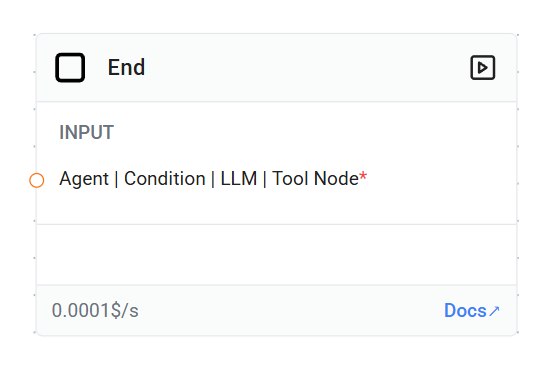
Node Details
- Name: End
- Type: End
- Version: 2.0
- Category: Sequential Agents
- Base Class: End
Parameters
The End node accepts one input parameter:| Label | Name | Type |
|---|---|---|
| Agent | Condition | LLM | Tool Node | sequentialNode | Agent | Condition | LLMNode | ToolNode |
Input/Output
Input
-
The node requires a predecessor node of type
ISeqAgentNode. - If no predecessor is provided, an error will be thrown.
Output
-
The node returns an
ISeqAgentNodeobject with the following properties:-
id: The unique identifier of the node -
node: Set to the constantEND -
name: Set to the constantEND -
label: Set to the constantEND -
type: Set to ‘end’ -
output: Set to the constantEND -
predecessorAgents: An array containing the input sequential node
-
Usage
The End node is typically placed at the conclusion of a Sequential Agents workflow. It ensures that the process terminates appropriately and doesn’t continue beyond the intended endpoint.Implementation Details
-
The node is implemented as a class named
End_SeqAgents. -
It implements the
INodeinterface. -
The
initmethod is responsible for processing the input and generating the output. -
The node uses the
ENDconstant from the@langchain/langgraphpackage to signify the termination point.
Documentation
For more detailed information on using the End node in Sequential Agents workflows, refer to the official documentation:Notes
-
The
hideOutputproperty is set totrue, indicating that the node’s output should not be displayed in the user interface. - This node is essential for properly structuring and terminating Sequential Agent workflows.

